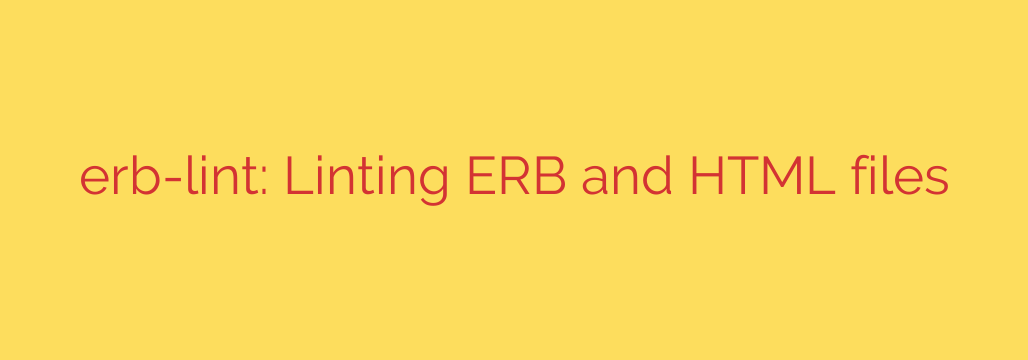
Master Your Rails Views: A Guide to Cleaner, More Secure Code with ERB-Lint
In any Ruby on Rails application, ERB templates are the bridge between your powerful backend logic and the user-facing HTML. But as projects grow, these .html.erb files can become a source of technical debt, filled with inconsistent formatting, subtle bugs, and overlooked accessibility issues. Maintaining code quality in your views is just as critical as it is in your models and controllers.
This is where a powerful static analysis tool comes into play. By automatically scanning your ERB and HTML files, a linter can enforce standards, prevent common errors, and significantly improve the health of your codebase.
What is a Linter and Why Do You Need One for ERB?
A linter is a tool that analyzes source code to flag programming errors, bugs, stylistic mistakes, and suspicious constructs. For Rails developers, tools like RuboCop are indispensable for maintaining Ruby code quality. ERB-Lint brings that same level of automated discipline directly to your view templates.
It parses your .erb files, separating the HTML structure from the embedded Ruby code. This allows it to apply specific rules to each part, ensuring both your markup and your embedded logic adhere to best practices.
Key Benefits of Integrating an ERB Linter
Adopting a linter for your ERB templates isn’t just about tidiness; it’s about building a more robust and maintainable application.
- Enforce Team-Wide Consistency: When multiple developers work on a project, styles can diverge. A linter ensures everyone follows the same formatting and coding conventions, making code reviews faster and the codebase easier to navigate.
- Catch Errors Before They Hit Production: Subtle issues like a missing closing tag, incorrect attribute usage, or invalid Ruby code inside ERB tags can be caught automatically, long before they cause problems for your users.
- Boost Accessibility (a11y): Modern web development demands accessible applications. ERB-Lint includes linters that check for common accessibility violations, such as missing
altattributes on images, improper use of buttons, and other issues that can be easily overlooked. - Enhance Security: Some linters are designed to spot potential security risks. For example, the
ErbSafetylinter can warn you about the unsafe use of therawhelper, which can expose your application to Cross-Site Scripting (XSS) attacks.
Getting Started: Installation and Configuration
Setting up an ERB linter is a straightforward process. You can begin by adding the erb-lint gem to your project’s Gemfile.
# Gemfile
group :development do
gem 'erb_lint'
end
Then, run bundle install.
After installation, the next step is to create a configuration file named .erb-lint.yml in the root of your project. This file is where you will enable and customize the specific checks (linters) you want to run.
A basic configuration might look like this:
# .erb-lint.yml
---
EnableDefaultLinters: true
linters:
Rubocop:
enabled: true
# Inherit your existing .rubocop.yml for consistency
rubocop_config: .rubocop.yml
ErbSafety:
enabled: true
RequireBEMComponents:
enabled: false # Example of disabling a linter
Accessibility/AltText:
enabled: true
This configuration enables the default set of linters, integrates your existing RuboCop rules for embedded Ruby, and explicitly turns on the crucial ErbSafety and AltText checks.
Running the Linter and Fixing Issues
Once configured, you can run the linter from your terminal against specific files or entire directories.
# Lint all ERB files within the app/views directory
bundle exec erblint app/views/**/*.html.erb
The tool will output a list of offenses, specifying the file, line number, and a description of the problem.
One of the most powerful features is its ability to automatically correct many of these offenses. By adding the --autocorrect flag, the linter will fix issues like formatting, whitespace, and other simple rule violations for you.
# Run the linter and automatically fix what it can
bundle exec erblint --autocorrect app/views/**/*.html.erb
Actionable Security Tip: Integrating into Your Workflow
To get the most value, don’t just run the linter manually. Integrate it into your Continuous Integration (CI) pipeline, such as GitHub Actions or CircleCI. By adding a step that runs erblint, you can automatically block pull requests that introduce new linting errors.
This creates a quality gate that ensures no subpar code makes it into your main branch, reinforcing best practices and keeping your view layer clean, secure, and maintainable for the long term. Adopting a tool like this is a small investment that pays huge dividends in code quality and developer productivity.
Source: https://www.linuxlinks.com/erb_lint-erb-html-files/








